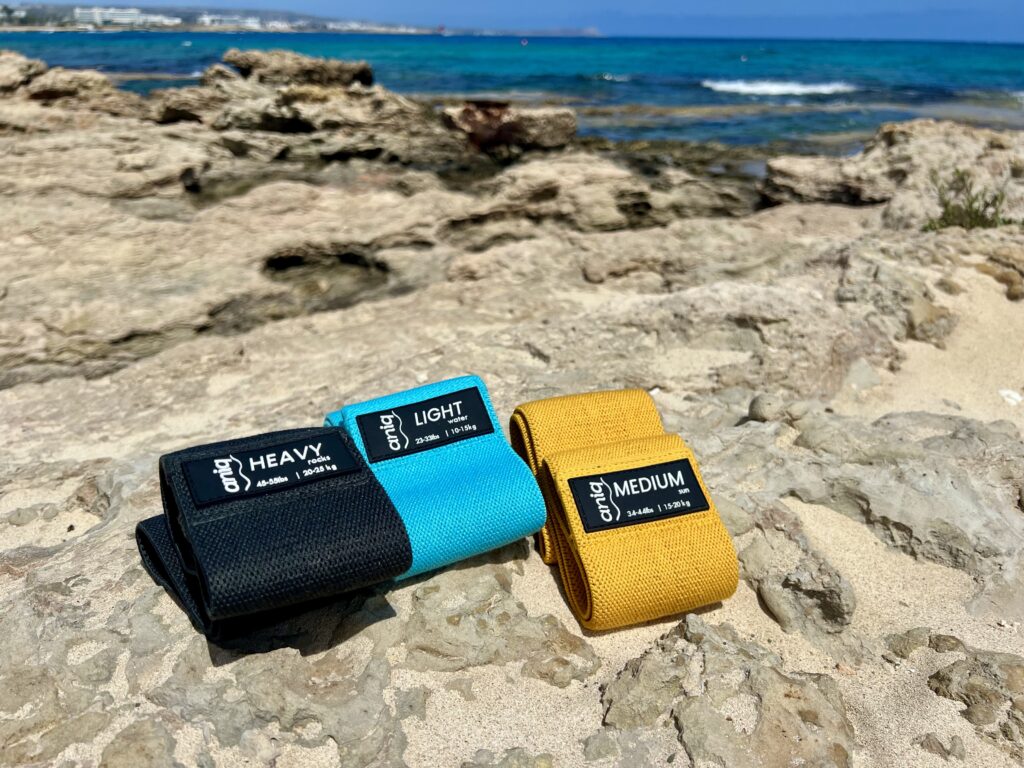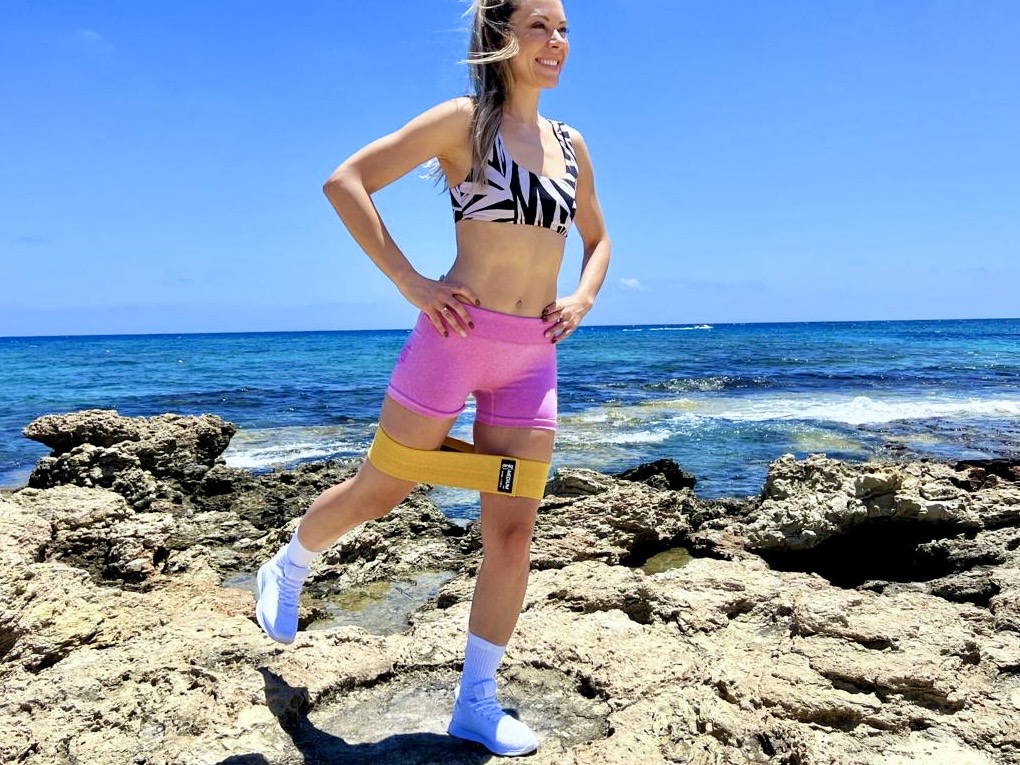Your glutes are more than just aesthetic—they’re essential for how you move, stand, and even how your body feels throughout the day. When they’re strong, you notice better posture, fewer aches, and more stability during everything from walking up stairs to lifting groceries.
A resistance band for buttocks is one of the simplest and most effective tools for building those muscles without needing a gym. The constant tension they create helps your glutes engage more deeply, which is often the missing piece for people who struggle to “feel” their glutes during traditional workouts.
In this guide, you’ll learn how resistance bands work, what muscles they activate, a full easy booty band workout for buttocks, and how to pick the right band for your fitness goals—so you can start feeling stronger, more confident, and more aligned from the ground up.
Benefits of Glute Exercises
Strong glutes aren’t just about shape—they play a central role in how your body moves and performs. Think of them as your engine for lower body power and stability. Incorporating glute exercises with a resistance band is one of the most effective ways to activate and strengthen these muscles for better performance and posture.
- Enhanced Posture and Balance: When your glutes are weak, your hips can tilt forward, which strains your lower back. Strengthening them helps align your spine and improves balance—especially important if you sit for long hours or have a desk job.
- Injury Prevention: Many common injuries, like knee pain or back discomfort, start from inactive or underdeveloped glutes. By building glute strength, you offload pressure from smaller joints and muscles, creating better body mechanics overall.
- Improved Athletic Performance: Whether you’re running, cycling, or lifting, your glutes are the powerhouse behind most athletic movement. A study published in the Journal of Strength and Conditioning Research found that athletes with stronger glutes demonstrated faster sprint speeds and better jump performance.
- Increased Metabolic Rate: Glute muscles are some of the largest in your body. When you build them, your body burns more calories even at rest. This makes consistent glute work a great complement to any fat-loss or toning routine.
What Muscles Will the Booty Band Exercises Affect?
When you use a resistance band for buttocks, you’re not just targeting one muscle—you’re engaging a whole network that supports movement, posture, and balance.
- Gluteus Maximus: This is the main muscle that gives your butt its shape and helps extend your hip when you walk, climb stairs, or stand up from a chair.
- Gluteus Medius and Minimus: These smaller, stabilizing muscles sit higher and deeper. They keep your hips level when you walk or balance on one leg. Weakness here often shows up as a “hip drop” or knee cave-in during squats.
- Hip Flexors and Extensors: These help move your thigh forward and backward. Balancing strength between them is key for better posture and injury prevention.
- Hamstrings and Quadriceps: While these aren’t part of the glutes, they work alongside them in nearly every lower-body movement. Strong coordination between these muscles improves your athletic efficiency and shape.
For example, lateral band walks—a staple glute exercises resistance band move—specifically fire up the gluteus medius. That’s the muscle responsible for hip stability and control during running or walking. Runners often find that adding this one exercise helps correct knee collapse and reduces IT band pain.
10 of the Best Resistance Band Glute Exercises
1. Glute Bridge with Band
Start by lying on your back with your knees bent and feet flat on the floor, hip-width apart. Place the band just above your knees.
Press through your heels, lift your hips toward the ceiling, and squeeze your glutes at the top. Keep your knees pushing gently out against the band to maintain tension. Lower back down slowly.
Targets: Gluteus maximus — helps strengthen your hips and improves posture by supporting your lower back.
2. Lateral Band Walk (Side Steps)
Step into the band and place it around your ankles or just above your knees. Slightly bend your knees and drop into a small squat.
Take small steps to the side, keeping constant tension on the band and your hips level.
Targets: Gluteus medius — stabilizes your hips and knees, reducing the risk of knee collapse or imbalance while walking or running.
3. Banded Kickbacks
Wrap the band around your ankles and stand tall, holding onto a wall or chair for balance.
Shift your weight to one leg, then kick the other leg straight back until you feel your glutes engage. Control the return.
Targets: Gluteus maximus — builds power and improves hip extension for walking, running, and climbing stairs.
4. Clamshells
Lie on your side with knees bent and the band just above your knees. Keep your feet together.
Open your top knee like you’re opening a book, then slowly bring it back down without losing control.
Targets: Gluteus medius and minimus — key for pelvic stability and balance, especially if you sit a lot.
5. Squats with Band
Place the band just above your knees, stand with your feet shoulder-width apart.
Push your hips back and bend your knees into a squat, pressing your knees slightly outward to keep tension in the band. Stand back up and repeat.
Targets: Glutes, quads, and hamstrings — helps shape the entire lower body and supports everyday movements like sitting and standing.
6. Fire Hydrants
Get on all fours with the band above your knees.
Keep your core tight and lift one leg out to the side, like a dog lifting its leg at a fire hydrant. Lower it with control.
Targets: Outer glutes (gluteus medius) — improves hip strength, balance, and helps stabilize your pelvis during movement.
7. Glute Bridge March
Lie on your back like a regular glute bridge with the band above your knees. Lift your hips up and hold them high.
Now, lift one knee toward your chest, lower it, then lift the other — like marching in place while keeping your hips stable.
Targets: Glutes and core — builds coordination, hip strength, and balance while engaging your abs to prevent hip drop.
8. Romanian Deadlifts with Band
Stand on the middle of the band with both feet, holding the ends in your hands.
With a soft bend in your knees, hinge forward at your hips while keeping your back flat. Drive your hips forward to stand tall and squeeze your glutes at the top.
Targets: Glutes and hamstrings — helps strengthen your posterior chain (the backside of your body), improving posture and power.
9. Curtsy Squats
Stand tall with the band above your knees. Step one leg behind and across the other, lowering into a curtsy-like squat.
Push through your front heel to return to start, then switch legs.
Targets: Gluteus medius and inner thighs — improves hip mobility and tones the outer and inner glutes for better leg symmetry.
10. Single-Leg Glute Bridge
Lie on your back with one foot flat on the floor and the other leg extended straight.
Lift your hips off the floor by pressing through your grounded heel. Squeeze your glutes at the top, hold briefly, then lower with control.
Targets: Gluteus maximus (on the working side) — builds strength evenly between legs, improving balance and reducing hip imbalances.
How Often Should I Use Glute Bands?
Consistency beats intensity when it comes to glute growth and toning.
- Beginners: Start with 2–3 sessions per week. This allows your muscles time to adapt and recover while still building a foundation.
- Intermediate or Advanced: You can increase to 3–4 sessions per week, alternating with other forms of training like cardio or strength work.
The key is recovery—your glutes grow when they rest, not just when you train them. If you’re sore, take a full day off before your next session. Over time, you can increase resistance or add more sets as your strength improves.
A good rule of thumb: if you can perform more than 20 reps easily, it’s time to move up to a heavier band.

Which Resistance Bands Are Best for Glutes?
Not all bands are created equal—and choosing the wrong one can make your workouts frustrating.
- Go for non-slip fabric or silicone grips. Fabric bands are especially good for glute work because they don’t roll up your thighs like cheaper latex ones.
- Choose a set with multiple resistance levels. Light bands are perfect for warm-ups or activation, while medium to heavy bands help you build real strength.
- Look for durability. Stitching and elasticity matter—a worn-out band can snap or lose tension quickly.
- Comfort counts. A wider band distributes pressure evenly and feels more stable during moves like squats or kickbacks.
Booty Bands on Amazon Australia are designed specifically for women’s glute training—they’re soft, non-roll, and come in three progressive resistance levels for home, gym, or travel workouts.
Get Your Booty Bands on Amazon
A resistance band for buttocks isn’t just another fitness gadget—it’s a compact, versatile tool that can truly transform how your body looks and feels. With regular use, you’ll notice better posture, stronger hips, and a more defined lower body—all without needing heavy gym equipment.
Start with the easy booty band on Amazon and workout for buttocks above, stay consistent for at least 4–6 weeks, and listen to your body’s feedback. You’ll likely feel more stable, energetic, and confident in how you move—and yes, your jeans will probably fit better too.
Your glutes aren’t just muscles—they’re the foundation of your strength. Train them with care, and they’ll support you in everything you do.

